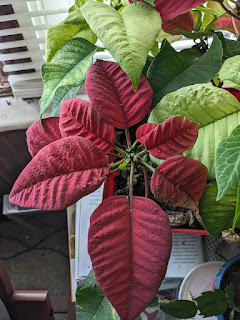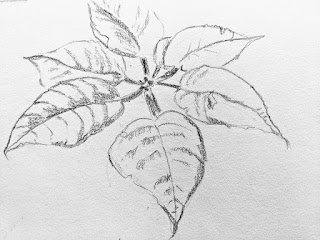Steve Mitchell is very experienced at just about all the media, but loves line and wash. Many of his spontaneous videos include line and watercolor.
In class we covered line and wash in general, but focused on three: pen and ink; graphite pencil; and colored pencil.
The colored pencil project included doing line in regular colored pencil. Colored pencil has a waxy base (some an "oil" base), and are slightly resistant.
We did this colored pencil:
Reference:

line drawing:

Added colored pencil:

Then I wet the paper with a large brush, and brushed in a wash of yellow and red.
I sprayed a little to let the color flow.
After it dried, I used some green in spots for negative painting.
I also darkened some centers that seemed a little washed out. (This was on rough paper, so I did have to go over a few things.)
Here is Steve Mitchell's YouTube about colored pencil and wash:
poinsettia line and wash
https://www.youtube.com/watch?v=iPZ5m8z2d_s
for examples of colored pencil OVER the wash:
https://www.youtube.com/watch?v=v-cjKb606vw
You can do line and wash with ink. I used this elephant reference to draw and ink in the wrinkles in this elephant. It is from Unsplash. On cold press paper.
I tried to use colors that I wouldn't use normally, this time quin gold and magenta. Just did a wash. Took about 30 seconds to do the color.
Used the same elephant reference. This time my line was graphite. I started with a normal #2B mechanical pencil. To darken and thicken lines I used a wood less graphite pencil set # 4 and #9 for the darkest.
This one is on hot press paper. I GLAZED over it with pthalo blue on the left and violet on the right.
Background is quin gold and hansa yellow.
The effect of the pencil is more subtle than ink, but I liked this a lot.
Here is a YouTube of Steve doing a goose in graphite.
There are some interesting hints about doing line and wash.
#1 You don't want it to look like this is traced. (Even if you did trace it.) Vary your line. Make your edges interesting.
#2 You can leave some undrawn areas for "lost edges", which can be very effective in creating a feeling of distance.
#3 If using a pen, use different sizes. Also, be creative in your lines. A good guide is a book by Claudia Nice on pen and watercolor.
#4 You can continue to do line, whether it is pen or colored pencil, even after you have done the paint.







No comments:
Post a Comment